
Original Link: https://www.anandtech.com/show/2429
Arctic Cooling Duo: Alpine 7 & Freezer 7 Pro Attack Value
by Wesley Fink on January 29, 2008 2:00 AM EST- Posted in
- Cases/Cooling/PSUs
CPU air-coolers are relatively cheap compared to other computer system components. With the top air-coolers selling in the $45 to $75 price range it is easy to forget that many buyers are really looking for that killer $15 cooler, or at least a $15 cooler that does its job without bringing too much attention to itself with overheating or a loud fan.
In the Intel cooling arena finding a good cheap cooler is particularly difficult, because the stock Intel cooler - included at no cost in Intel Retail CPU packages - is today both a very good performer and very quiet. This makes competing in the value segment particularly difficult for companies aiming at the Socket 775 market.
One company that targets this value market segment is Arctic Cooling. Arctic Cooling is a privately owned company founded in 2001. Headquarters are located in Switzerland, with offices in Hong Kong and the USA, while production is in China. The company specializes in producing thermal cooling solutions for CPUs, GPUs (video chips), and PC cases.
In the few years since its inception, the Arctic Cooling family of coolers has earned a solid reputation for good value in the cooler market. Reputation is one thing and performance is often quite another, so it is time to give that reputation a test in the harsh reality of our cooler test bed. The questions we aim to answer are:
- Does the entry Alpine 7 outperform the stock Intel cooler? This is another way of asking whether anyone should bother with the Alpine 7; if the cooler does not outperform the stock Intel unit there is no real reason to buy it.
- Are noise levels well controlled at both stock and overclocked settings?
- Does the price increase of the Freezer 7 Pro buy equivalent performance improvements? I.e., is it worth the extra cost to buy the Freezer 7 Pro over the Alpine 7?
- How do performance and noise levels compare to the best coolers tested at AnandTech?
To provide answers, we dropped the Alpine Cooler pair into our new cooling test bed.
The Arctic Coolers
Both the Alpine 7 and the Freezer 7 Pro use a frameless 92mm fan, but the output and bearing design differ by model. The frameless fan is a design feature that distinguishes Arctic Cooling designs.
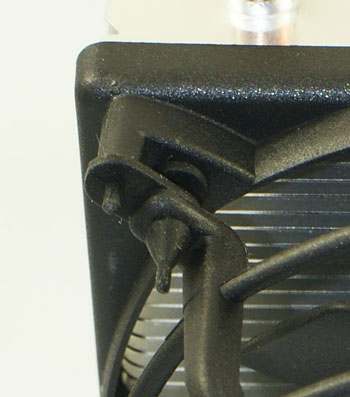
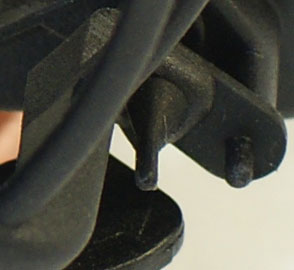
The fan mount is also a trademark feature. AC coolers use elastomeric mounts to isolate the fan and reduce noise levels. This is true even on the $12 entry-level Alpine 7 (with PWM) cooler. The frameless fan with elastomeric mounts is a similar design on both coolers, but there little else is the same. The Alpine 7 is a one-piece aluminum block; it uses a traditional down-facing fan, much like the Intel retail cooler and other entry-level coolers.
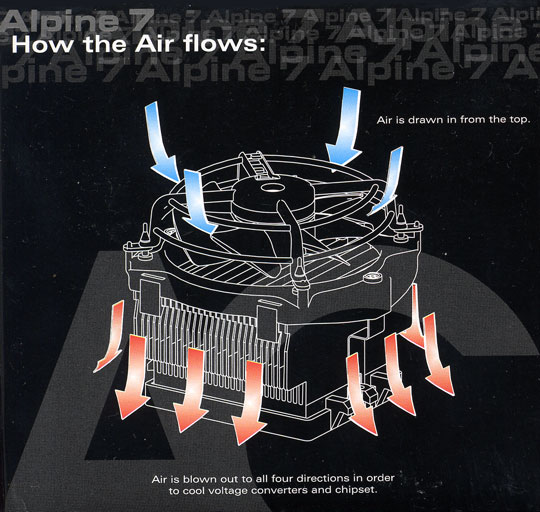
The Alpine 7 consists of several models. Our test unit is the Alpine 7 (with PWM), which is basically an Alpine 64 with a custom cage for mounting on Socket 775. This model will mount on any current AMD or Intel socket. Other models are the Alpine 64 Pro for Intel 775 only and the Alpine 64/Alpine 64 (with PWM) for AMD only. All these variations use a heatsink that is basically the same and a down-facing fan with the same fan specifications. Performance should be the same across these coolers. Arctic Cooling also has a smaller cooler with a smaller 80mm fan where small size is important, the Alpine 7 GT.
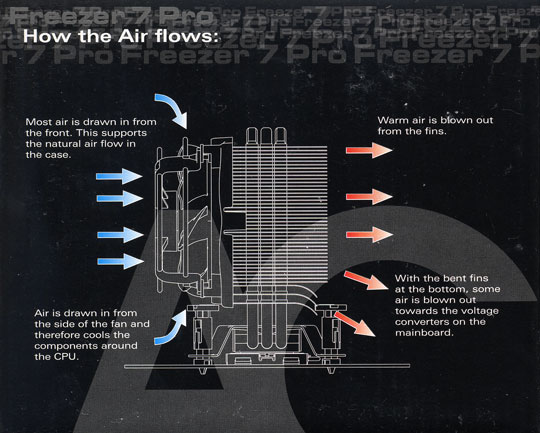
The midrange Freezer 7 Pro is a side-mounted heatpipe tower. Three vertical heatpipes are looped through a heavy base and support horizontal aluminum cooling fins. Airflow exhausts toward the rear fans in the case. All the top performing coolers tested in recent months at AnandTech use a heatpipe tower design.
Alpine 7 (with PWM)
The Alpine 7 family consists of entry-level CPU coolers with street prices of $12 to $15. All the coolers use the same 92mm fan with a heatsink that is the same heatsink with slight modifications for different mount systems. The only exception is the small Alpine 7 GT that uses a smaller heatsink and 80mm fan. The tested Alpine 7 (with PWM) is a universal mount version. The version most readers will be familiar with is the Alpine 7 Pro, which is the same cooler with notched corners for the Intel pushpin mount.
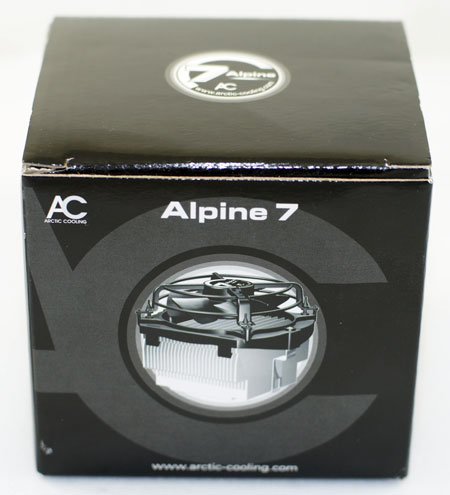
Packaging for all the Arctic Cooling models uses a black background and the AC7 logo.
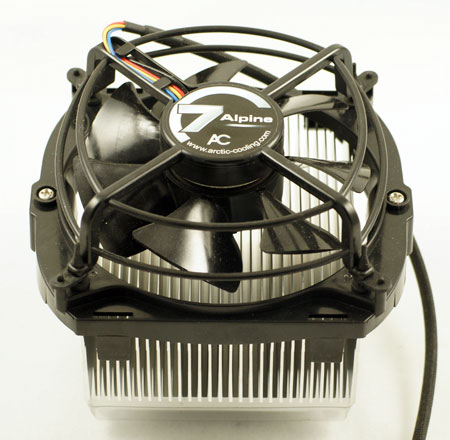
Inside the box, you will find the fully assembled Alpine 7 (with PWM). The basic heatsink in this version is the Alpine 64 designed with clips for AMD mounting. This version includes a custom cage and bottom plate to allow secure mounting on a Socket 775 motherboard. This gives you the choice on Socket 775 of the Alpine 7 (with PWM) for through the motherboard mount and the Alpine 7 Pro for quick pushpin mounting.
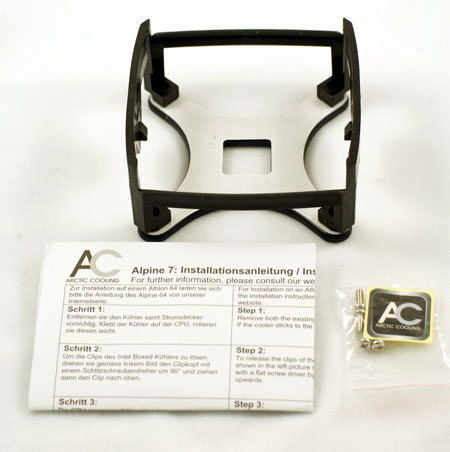
Accessories include the base plate and screws for mounting on Socket 775 and an Alpine Cooling sticker for your case and instructions. The heatsink has a very viscous thermal compound pre-applied to the bottom of the cooler. The base heatsink is ready to mount to current AMD sockets, including AM2.
Specifications
The frameless 92mm fan is used in all the 92mm Alpine 7 family coolers. The heatsinks in the family all use the same design and are within a few grams of each other in weight.
| Alpine 7 (with PWM) | |
| Heatsink Dimensions | 78(W) x 98(D) x 56mm(H) |
| Dimensions with Fan | 113(W) x 101(D) x 91.7mm(H) |
| Weight | 486g (17.1 ounces) |
| Material | Aluminum |
| Cooling Capacity | 90W |
| Configuration | Down-Facing Fan |
| Alpine Fan | |
| Fan Size | 92 mm |
| Fan Module Dimensions | 113mm x 101mm x 47.2mm |
| Fan Speed | 300-2000 rpm (controlled by pwm signal) |
| Connector | 4-pin (PWM) |
| Fan Bearing | Fluid Dynamic Bearing |
| Rated Life | 400,000 hours (MTTF@40C) |
| Maximum Airflow | 36 CFM |
The Arctic 7 (with PWM) fan is a high spec 92mm using a Fluid Dynamic Bearing for silence and long life. You may recall that one of the top fans we have tested, the Scythe S-FLEX, uses Sony Fluid Dynamic Bearings to minimize noise.
Installation
The Alpine 7 (with PWM) is easy to mount, but it will require the removal of the motherboard, since the mounting plate attaches to the bottom and the Socket 775 cage screws in from the top of the cage. This is a great deal more trouble than the Alpine 7 Pro, which does not require motherboard removal and is an easy pushpin mount. However, the universal Alpine 7 (with PWM) rewards you for the trouble with an extremely secure mount on your Socket 775 board. If you are a LAN party gamer this could be a good, secure, and easily transported cooler for your system.
The mounting cage for the universal model has mount clips inside the sides of the cage. This requires loosening the mount clip screws so the clips can drop down a bit. You then pop in the clips and tighten the screws until the clip is firmly seated. It's a bit of trouble but the final mount is exceptionally secure.
If you find these instructions intimidating buy the Alpine 7 Pro as the mount is as easy as it gets with that model. You just push the four clips down until they lock in the four holes around the CPU socket. It's easy, but many do not feel this mounting method is as secure as a through-board mount like the Alpine 7 (with PWM).
Freezer 7 Pro
The tested Freezer 7 Pro is an Intel Socket 775 mount. The cooler is also available for current AMD sockets as the Freezer 64 Pro.
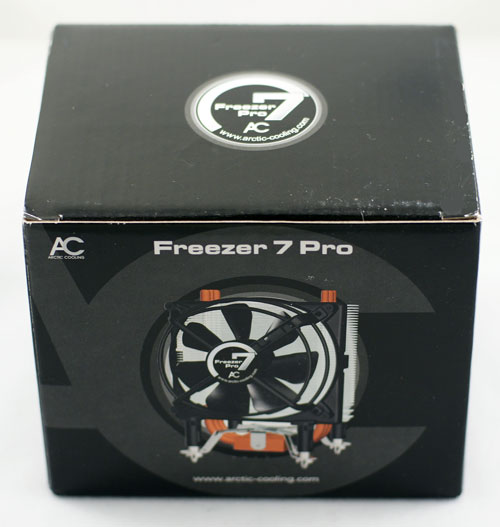
Packaging for the Freezer 7 Pro follows the family image of the Arctic 7 with a similar black background and the AC7 logo.
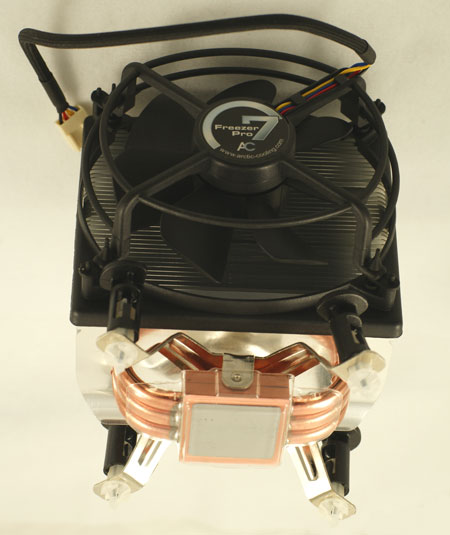
The fully assembled Freezer 7 Pro comes packaged in a protective styrene shell. Everything is pre-assembled. Even the thermal compound is pre-applied.
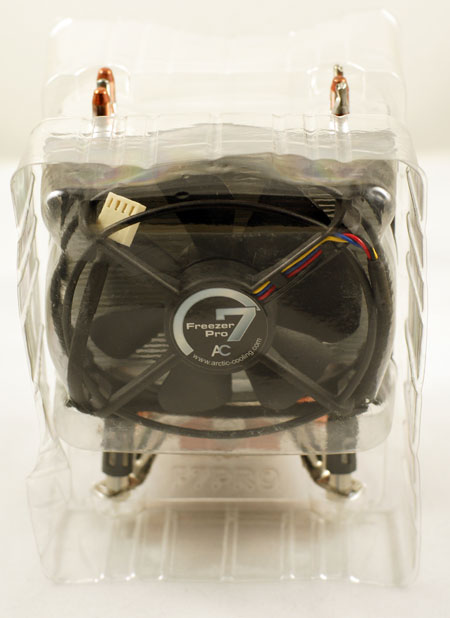
The only accessory for the Freezer 7 Pro is the Installation Instructions and an Arctic Cooling label to stick somewhere if you want to use it. There is absolutely nothing that needs to be attached to the cooler. If you like simple this is as good as it gets for a heatpipe tower.
Specifications
The Freezer 7 Pro is a side-facing fan heatpipe tower, similar in concept to many of the top coolers tested recently at AnandTech. It originally entered the market at around $35, but the price has dropped since to the $22 to $25 range, making it very affordable for this type of cooler. The Freezer 7 Pro is still small compared to coolers like our top Thermalrights, or the Scythe Infinity or Tuniq Tower. All those top coolers use 120mm fans, where the Freezer 7 Pro uses a 92mm fan.
| Freezer 7 Pro | |
| Heatsink Dimensions | 104(W) x 58(D) x 126.5mm(H) |
| Dimensions with Fan | 107(W) x 96.5(D) x 126.5mm(H) |
| Weight | 520g (18.3 ounces) |
| Material | Aluminum Fins with Copper Heatpipes |
| Cooling Capacity | 130W |
| Configuration | Heatpipe Tower with 3 U-Loop Heatpipes |
| Freezer Fan | |
| Fan Size | 92 mm |
| Fan Module Dimensions | 107mm x 43.5mm x 96mm |
| Fan Speed | 300-2500 rpm (controlled by pwm signal) |
| Connector | 4-pin (PWM) |
| Fan Bearing | Arctic Ceramic Bearing |
| Rated Life | 137,000 hours (MTTF@40C); 274,000 hours (MTTF@30) |
| Maximum Airflow | 46 CFM |
The Freezer 7 Pro fan itself is 92mm and frameless like the Alpine 7, but it is rated for higher output. Strangely, the higher output Freezer 7 Pro fan uses a lower life ceramic bearing instead of the long life Fluid Dynamic Bearing featured in the cheaper Alpine 7.
Installation
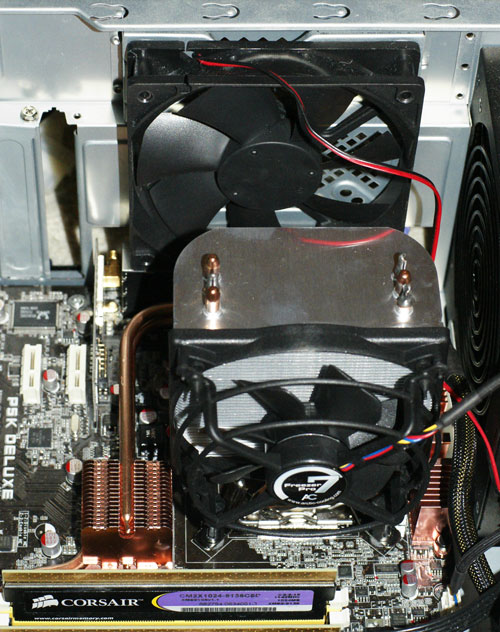
Even the thermal compound comes pre-applied so mounting is incredibly easy. Push the four pins in the holes until they click and the cooler is mounted. The pushpins are not our favorites for secure mounting, but they seem very adequate for this lighter weight heatpipe tower. Installation is the easiest we have ever seen, which should be welcome news for mechanically challenged cooler installers.
CPU Cooling Test Configuration
All tests use our new cooling test bed. This consists of a Rosewill R604-P-SL case sold by Newegg without a power supply. The Rosewill is typical of a moderately priced mid-tower case our readers might own. We chose this case because it is a Newegg top seller and includes a variable front intake louver and a quiet 120mm exhaust fan at the rear of the case. The case is also screw-less with components held in place by plastic holders instead of metal-to-metal connections. This appears to reduce case vibration and noise.
The power supply is a Corsair HX620W, which has proven in benchmarks to be an exceptionally quiet unit. The HX620W features a variable speed exhaust fan and a down-facing intake fan mounted just above the CPU space in the case. To eliminate the video card as a source of noise we have moved to a fanless card. Since we will move to Vista and DX10 in the very near future, the test bed runs an MSI NX8600 GTS that supports DX10 and cools with heatsinks and heatpipes. The reduced noise power supply and fanless video card have the potential to dramatically lower system noise in the test bed.
The motherboard is the ASUS P5K Deluxe. This P35 chipset motherboard has exhibited outstanding overclocking capabilities in our testing. It can also mount the newest 1333 FSB Intel Core processors and can handle our existing high-speed DDR2 memory. The P5K3 uses heatsinks and heatpipes to cool board components so all motherboard cooling is passive. There are no active cooling fans to generate unwanted noise during testing.
The 120mm exhaust fan mounted to the rear of the case is below the system noise floor. We run that fan during performance and overclocking tests. However, system noise can be cumulative, so we turn off the exhaust fan during noise testing.
| Cooling Performance Test Configuration | |
| Processor | Intel Core 2 Duo
X6800 (Dual-core 2.93GHz, 4MB Unified Cache) |
| RAM | 2x1GB Corsair Dominator PC2-8888 (DDR2-1111) |
| Hard Drive(s) | Hitachi 250GB SATA2 enabled (16MB Buffer) |
| Video Card | MSI NX8600GTS (fanless) - All Standard Tests |
| Intel TAT | Version 2.05.2006.0427 |
| CoreTemp | Version 0.95 |
| Video Drivers | NVIDIA 163.71 |
| CPU Cooling | Arctic Cooling Alpine 7 (with
PWM) Arctic Cooling Freezer Pro 7 ZEROtherm Nirvana NV 120 Cooler Master Hyper 212 OCZ Vendetta Scythe Kama Cross Swiftech H2O-120 Compact Corsair Nautilus 500 Thermalright Ultima-90 ZEROtherm BTF90 Xigmatek AIO (AIO-S800P) Evercool Silver Knight Enzotech Ultra-X 3RSystem iCEAGE Thermaltake Big Typhoon VX Thermaltake MaxOrb Scythe Andy Samurai Master Cooler Master Gemini II Noctua NH-U12F Asus Silent Square Pro Scythe Ninja Plus Rev. B OCZ Vindicator Thermalright Ultra 120 Extreme Thermalright Ultra 120 Scythe Infinity Zalman CNS9700 Zalman CNS9500 Cooler Master Hyper 6+ Vigor Monsoon II Lite Thermalright MST-9775 Scythe Katana Tuniq Tower 120 Intel Stock HSF for X6800 |
| Power Supply | Corsair HX620W |
| Motherboards | Asus P5K Deluxe (Intel P35) |
| Operating System | Windows XP Professional SP2 |
| BIOS | Asus AMI 0501 (06/26/2007) |
We run all cooling tests with the components mounted in the standard mid-tower case. The idle and stress temperature tests are run with the case closed and standing as it would in most home setups. Room temperature is measured before beginning the cooler tests and is maintained in the 20 to 22C (68F to 72F) range for all testing.
For consistency of test results, we use a standard premium silver-colored thermal compound. In our experience, the thermal compound used makes little to no difference in cooling test results. This is particularly true now that processors ship with a large manufacturer-installed heatspreader. Our current test procedure uses this standard high-quality silver-colored thermal paste for all cooler reviews.
For comparison, we first tested the stock Intel air-cooler at standard X6800 speeds and measured the CPU temperature at idle. We then stress the CPU by running continuous loops of the Far Cry River demo. We repeat the same tests at the highest stable overclock we could achieve with the stock cooler. "Stable" in this case is the ability to handle our Far Cry looping for at least 30 minutes without crashing.
The same benchmarks are then run on the review cooler(s) at stock speed, 3.33GHz (10x333) at stock voltage, highest stock cooler OC speed (3.73GHz), and the highest OC that could be achieved in the same setup with the cooler being tested. This allows measurement of the cooling efficiency of the test unit compared to stock and the improvement in overclocking capabilities, if any, from using the test cooler.
We compare cooling results with a representative sample of air and water-cooling results measured with CoreTemp. TAT provides a similar core measurement, but test results with CoreTemp are more consistent over a wide range of test conditions than the results reported by TAT. We retested previously reviewed coolers with CoreTemp under idle and load conditions. In benchmarks where the new test bed makes no apparent difference, like maximum overclock, we include results for all coolers tested since beginning cooling reviews in early 2007.
Noise Levels
In addition to cooling efficiency and overclocking abilities, users shopping for CPU cooling solutions may also be interested in the noise levels of the cooling devices they are considering. We measure noise levels with the case on its side using a C.E.M. DT-8850 Sound Level meter. This meter allows accurate sound level measurements from 35b dB to 130 dB with a resolution of 0.1 dB and an accuracy of 1.5 dB. This is sufficient for our needs in these tests, as measurement starts at the level of a relatively quiet room. Our own test room, with all computers and fans turned off, has a room noise level that has been reduced slightly to 35.0 dB(A) compared to the previous 36.4 dB(A). With the new test bed, the system noise at idle is 36.5 dB(A) at 24" and 37.8 dB(A) at 6". This is better than our previous system noise floor of 38.3 dB(A) at 24". The noise reduction at the 6" distance is dramatically lower than the previous test bed floor of 47 dB(A).
Cooling at Stock Speed
Some users will never overclock their CPU, but they still want to run the coolest CPU temperatures possible to enhance stability and extend CPU life. We compile all temperature benchmarks with CoreTemp, a public domain utility that is quite stable with reproducible results on the Intel platform. This required retesting a cross-section of the best coolers evaluated so far at AnandTech. To better document performance in the large speed gap between 2.93 GHz and 3.73 GHz, we added the intermediate value of 3.33 GHz to all test results during the retest of the coolers.
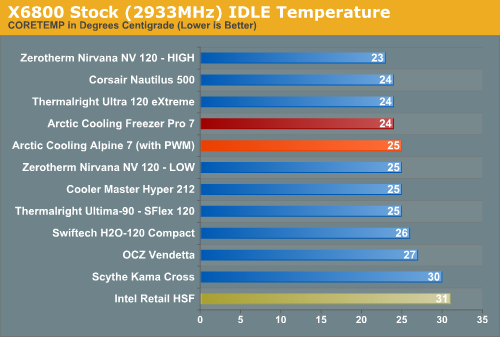
Performance at stock idle is amazing for the Alpine 7 - a cooler that costs less than $15. The Freezer 7 Pro does slightly better, but both perform much better than you might expect at this price point. Where the very good Intel stock air-cooler keeps the X6800 at 31C at idle, the Alpine 7 reduces that to 25C and the Freezer 7 Pro is one degree lower at 24C. This compares to the top Thermalright Ultra 120 eXtreme at 24C, Corsair water-cooling at 24C, Swiftech water-cooling at 27C, and ZEROtherm Nirvana at 23C. In comparing results, please keep in mind the test results from the new cooling bed using CoreTemp are not directly comparable to earlier cooling results.
It is more difficult to simulate all the various stress conditions a computer may encounter in different operating environments. For most home users, contemporary gaming is one of the most demanding CPU (and system) applications. Therefore, our stress test simulates running a demanding contemporary game. We loop the Far Cry River demo for 30 minutes and capture the CPU temperature with CoreTemp's "logging" option. We report the highest temperature during the load test. We ignore momentary spikes and report a sustained high-level temperature that you are likely to encounter in this type of scenario. This test configuration roughly equates to an 80% CPU load test using Intel TAT, another respected program for thermal measurements.
We next compare cooling efficiency of the Arctic Cooling HSFs under load conditions at stock speed to the retail HSF and other recently retested CPU coolers.
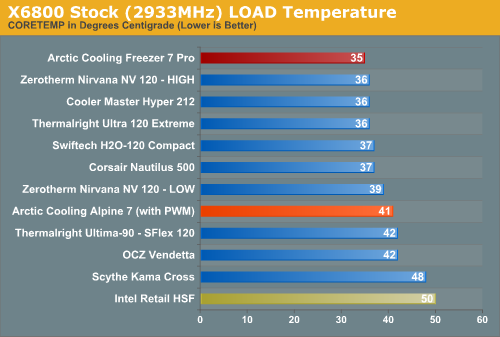
The Freezer 7 Pro turns in an outstanding performance under load at stock speeds. CoreTemp results are 35C, which is one of the best air-cooling results tested so far at AnandTech. The Alpine 7 is also a terrific performer under load at 40C. This sub-$15 cooler is a significant improvement over the stock Intel fan, which reaches 50C under load at stock speed in our cooling test bed.
If you do not plan to push overclocking to the extreme, the Freezer 7 Pro is an outstanding choice. The stock performance at idle and load is among the best we have tested - matching or coming in a bit better than the Thermalright Ultra 120 eXtreme. The Alpine 7 is frankly cheap to buy, but it still significantly outperforms the stock Intel cooler at stock speeds. These reasonably priced coolers from Arctic Cooling are great choices if you want better cooling at standard CPU speeds.
Noise Levels
For many enthusiasts upgrading cooling the goal is maximum stable overclock, and they will live with the inconvenience of a louder system. For other users silence is the most important factor, and these users will forgo maximum overclocking if that increases system noise levels. Those who expect silence to be the domain of high-priced cooling solutions are in for a very pleasant surprise with both these Arctic Cooling solutions. It is unusual to see this much attention paid to noise reduction in value coolers, but the use of elastomeric bushings and low noise bearings show that Arctic Cooling takes noise reduction very seriously. Do these features work?
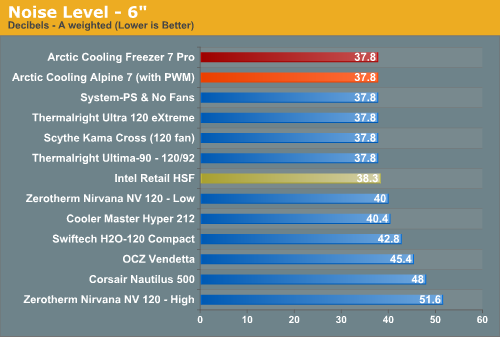
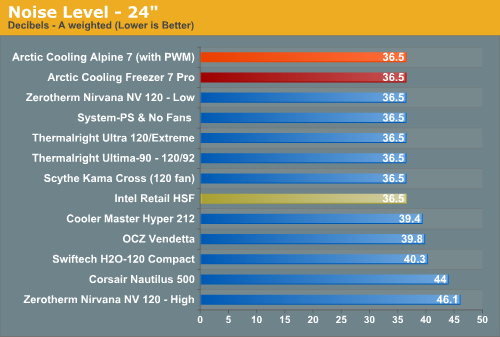
The Arctic 7 (with PWM) and the Freezer 7 Pro turn out to be two of the quietest coolers we have tested so far in our new cooling test bed. All four test results are at the floor of our system noise, and the new test system noise floor is equivalent to a suburban bedroom at night in noise level.
Both Alpine coolers remain silent, even when pushed hard with load testing and overclocking, which increases fan speeds. It is rare to see such low noise levels on any cooling fan, but it is particularly impressive in coolers designed to sell for less than $25.
Neither of these sub-$25 coolers will really challenge the top of our overclocking performance results, but in their effective range - which is wider than you might expect - both coolers are extremely quiet. The frameless fan, low noise bearings, and elastomeric fan mounts are obviously doing their job very well.
Overclocking and Performance Scaling
With outstanding performance at stock speed, we pushed the Arctic Cooling HSFs in our performance scaling tests to see if these air-coolers deliver similarly impressive performance when overclocking. As cooling solutions do a better job of keeping the CPU at a lower temperature, it is reasonable to expect the overclocking capabilities of the CPU will increase as cooler performance increases. In each test of a cooler, we measure the highest stable overclock of a standard X6800 processor under the following conditions:
CPU Multiplier: 11x (Stock 11x)
CPU Strap: 266 (stock) or 333 (overclocked)
CPU voltage: 1.5875V at Max overclock
NB Voltage: 1.70V
FSB Voltage: 1.40V
SB Voltage: 1.20V
Memory is set to Auto timings on the P35. This removes memory as any kind of impediment to the maximum stable overclock. As FSB is raised the linked memory speed increases in proportion. For this reason, we maintain memory speed as close as possible to CPU strap settings to prevent memory becoming an issue in CPU testing. This means 3.33GHz uses a 333 strap and runs 10x333, 3.73 uses a 333 strap and runs 11x339, and 3.90 GHz is a 333 strap and 354x11. The stock speed test is a 266 strap and 11x266. We may move in the future to a 3.0GHz stock speed with a 333 strap and 9x333 settings for complete consistency, but since we are not measuring raw computer performance in our cooling benchmarking this becomes a moot point. We use the same processor in all cooling tests to ensure comparable results.
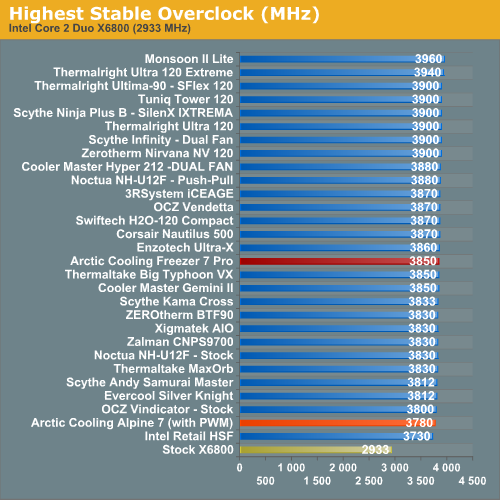
The Alpine 7 is rated at 90 watts heat dissipation, which means it should overclock a little better than the stock Intel cooler. That is exactly what we found in the overclocking tests, with a top overclock of 3.78GHz compared to the Intel top overclock of 3.73GHz.
The Freezer 7 Pro is rated at 130 watts dissipation and it lives up to that level of performance, topping out at 3.85GHz. This does not challenge our top coolers, which can dissipate more than 150W - or even 165W in the case of the Thermalright Ultra 120 eXtreme. Nonetheless, it is very competent performance for a cooler selling for less than $25. Many other coolers we have tested that sell for much more than these two coolers do not perform as well in overclocking.
Those who expected the Alpine 7 family or Freezer 7 Pro might give our top performing coolers a run for the top will likely be disappointed. However, they shouldn't be disappointed with either cooler's overclocking performance. It is very clear Arctic Cooling knows how to design and rate their coolers for performance. Both the Alpine 7 and the Freezer 7 Pro are fairly rated and outstanding performers in their respective price classes.
Performance Scaling
Performance scaling charts for the Arctic Cooling pair use a scale with zero on the bottom and 75C on the top. Keep in mind that the lower line is the best performance in this presentation of the data - lower temperatures represent better performance.
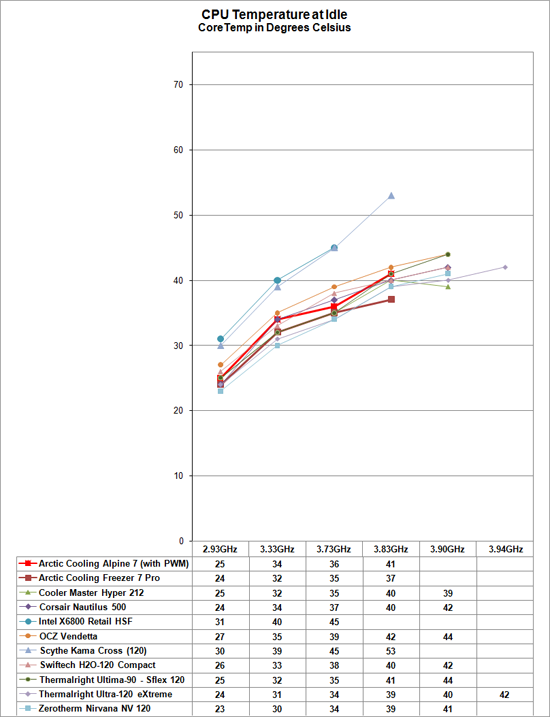 |
The Alpine 7 performance scaling at idle is impressive. It significantly outperforms the Intel retail cooler, which would be the closest competitor. Surprisingly it also outperforms most of the mid-range coolers we have tested to the point where it tops out at 3.78GHz. The Freezer 7 Pro is even better, with scaling close to the top guns to its max speed of 3.85GHz.
Comparing cooling efficiency of the Arctic Coolers under load conditions to the retail HSF and other recently retested CPU coolers doesn't change the picture much. Load testing can be very revealing of a cooler's efficiency. A basically flat line, particularly form 3.73GHz upward, indicates the cooler is still in its best cooling range. A rapidly rising line indicates a cooler is nearing the end of its ability to cool efficiently. Lines that parallel the best coolers over a range of values show the coolers provide similar cooling performance.
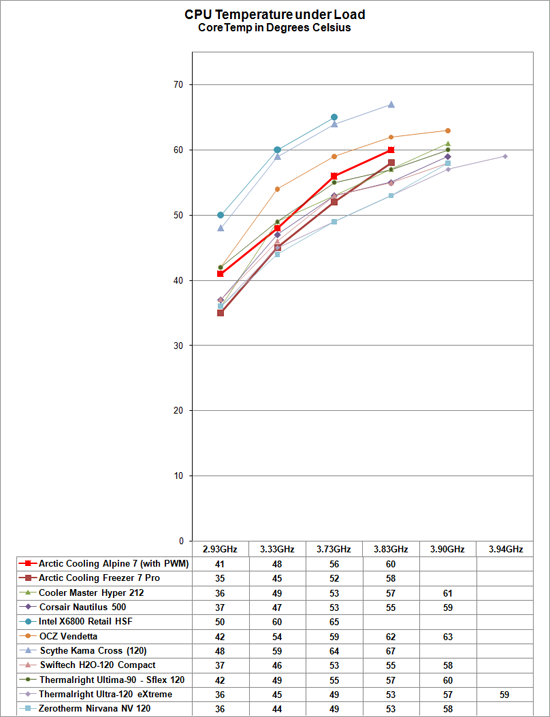 |
Under load test conditions, the limited performance of both these coolers is more noticeable. Top coolers we have tested exhibit a shallower slope, where the Alpine 7 and Freezer 7 Pro both have very steep curves in load performance scaling. Results at 2.93GHz and 3.33GHz are among the best test results so far, but the Alpine 7 drops rapidly into the entry/mid performance levels at 3.73GHz and its top of 3.78GHz. Keep in mind that this is a very low-priced cooler and you can get more excited about load scaling, because performance is still significantly better than the stock cooler.
The Freezer 7 Pro fares better under load, as might be expected of a small heatpipe tower. Load performance matches the top tier until around 3.5Ghz. Load scaling then drops into the mid-range area from 3.73GHz to the top for this cooler of 3.85GHz. This is still excellent performance for a cooler in this price range.
Final Words
For the money the performance of the Alpine 7 and Freezer 7 Pro are both simply outstanding. The Alpine 7 sells for less than $15 and it handily outperforms the excellent stock Intel cooler that comes with kit CPUs. Many higher-priced coolers barely outperform the Intel, and the Alpine 7 turns in a significantly better performance than the benchmark Intel retail design. The Freezer 7 Pro fares even better. This sub-$25 cooler exhibits performance scaling that is much better than we had any right to expect at this price point. It also pushes overclocking to a very good 3.85GHz, which is a record for this price point.
Both coolers are also superb in cooling at stock CPU speeds, under both idle and load conditions. In fact, they are so good at stock performance that it is easy to recommend one of these coolers as a way to extend your CPU life even if you have no intention of overclocking. That is particularly true when you consider how quiet both coolers are. Either cooler is near silent in most situations.
Arctic Cooling obviously used quite a few tricks with these coolers to keep noise low, and they succeeded very well in reaching that goal. Low-priced coolers are supposed to sacrifice noise and longevity to keep the price down, but neither of these coolers gives up anything on either count. They both use low noise, longer-life fan bearings and elastomeric fan mounts. This is expensive engineering, and this attention to sound engineering succeeds in making the Arctic Coolers amazingly quiet.
It is true the Arctic Cooling duo did not break through the top of our cooler performance charts, but they do something too few products do today. Both the Alpine 7 and Freezer 7 Pro meet or exceed their specifications. Both also deliver competent and silent performance with simple but effective engineering while delivering exceptional value for their price. Exceptional value is always a good thing and you will never regret the small amount you spend on either of these coolers. They are not the best performing coolers you can buy today, but both are the top performing cooler you can buy at their respective price points. There's nothing wrong with earning the distinction of "Best Buy for the Money".







